|
|
Astérus

|
|
 |
|
|
The exquisite Astérus was one of the foundation pillars for the breeding dynasty of Marcel Boussac. A horse with a high class pedigree and top class performance, his athleticism was only exceded by his ability to pass on his superior genes and improve everything he touched. Astérus's sons and daughters took Boussac to the top of the French breeders and owners lists and kept him there for nearly 30 years.
In 1920, Marcel Boussac purchased the yearling filly Zariba (1919 by Sardanapale out of St. Lucre by St. Serf) from Baron Maurice de Rothschild. She became the champion filly of her crop at 2 and 3, so he went back to the same source in 1924, and purchased a colt by Teddy out of the mare Astrella for 210,000 francs. The name Boussac gave him, "Astérus" (from the Greek word "aster" for "star"), was in keeping with the colt's family tradition, descending as he did from the mare Stella and her daughter Astrology, the same family as the good colt and American Leading Sire Star Shoot. Distantly, he also shared the female line with Zariba herself, both Rothschild-breds descending from the mare Maid of Masham.
Astérus's sire, Teddy (1913 by Ajax - Rondeau by Bay Ronald) was bred by Edmond Blanc at Haras de Jardy and sold to Jefferson Davis Cohn as a yearling. Teddy was the wartime champion of his age in Spain and France, and went to stud in France, embarking on a vastly influential stud career that covered Europe and crossed the Atlantic to America. Teddy sired a wide palette of aptitudes, able to get top 2-year-olds, classic milers, and stayers alike. When Astérus was conceived, he was standing at the Haras de Fitz-James in 1922, before Cohn had shifted his bloodstock to Haras du Bois Roussel.
Baron Maurice de Rothschild, cousin to Baron Edouard de Rothschild, had a stud at Haras de Champagne St. Hilaire. The property is still active as a horse farm but is now a standardbred stud. His mare, Astrella, was unraced, foaled in 1912, and her racing career in France was compromised due to the ravages of World War I. She was bred well, though, being a daughter of Verdun and St. Astra. Verdun (1906 by Rabelais - Vellena by Gournay) was one of the best racing offspring of Rabelais, a son of St. Simon who took up stud duties in France with great success. When a 3-year-old in 1909, Verdun won the most precious prize in French racing at the time, the Grand Prix de Paris, and also the Poule d'Essai des Poulains (French 2,000 Guineas) among his 8 wins. Verdun's full sister, Vellica, won the Poule d'Essai des Pouliches (French 1,000 Guineas) the following year.
As a stallion, Verdun was not a raging success in France, although he sired a few stakes winners, as well as the mares Astrella (dam of Astérus) and Poule au Pot (dam of the Idle Hour Farm broodmare Bird Loose, by Sardanapale). He was sent to Argentina in 1917 where he found a more favorable climate, and became a leading sire there. In Argentina, he sired Barranquero and the mare Consulta (second dam of the classy race mare Miss Grillo).
Astrella's dam was St. Astra, a filly that had won the Prix de Diane (French Oaks), so was of the highest class. St. Astra had also produced the Poule d'Essai des Pouliches (French 1,000 Guineas) winner Diavolezza, who became a good producer, and stakes-placed Titanite, also a good producer. St. Astra's dam, St. Celestra, was a half-sister to the American Leading Sire, Star Shoot.
It is possibly this female line that attracted Boussac to the Rothschild yearling by Teddy out of Astrella at the Deauville sales in 1924. He already owned Zariba, from the same female line (going back to Maid of Masham), also the same female line as Fair Play and Friar Rock, a pair of outstanding horses doing well at stud in America at the time. Being a breeder who appreciated doubling back to good females, Boussac probably bought Astérus with every intent of standing him at stud in the future. And it's no surprise that one of Astérus's best offspring came when he was bred to Zariba, getting the excellent colt ARBAR.
Astérus on the Turf
Trained by Robert Denman, Astérus made 4 starts as a 2-year-old in 1925, and although he didn't win a major stakes, he was the third highweight among his age that year, behind the filly Dorina, and his own stablemate Banstar. At 3, Asterus ran 9 times, winning the Poule d'Essai des Poulains (French 2,000 Guineas, 1600 meters) by 3 lengths, and the Prix Greffulhe (2100 meters), in which he beat Biribi by a neck, (Biribi became the champion of that French crop). He was second in the Grand International d'Ostende to the Teddy son Ptolemy, beating Biribi for the place, third in a 32 horse field in the Cambridgeshire Handicap, and fourth in the Prix du Jockey Club.
At 4, Astérus won twice in England under the charge of Sam Darling, the Royal Hunt Cup (7f.) beating Apelle in a field of 29 and Champion Stakes (10f.) defeating the excellent Colorado by half a length in a field of just 3 (the third being Embargo). He also dead-heated for third in the Lincolnshire Handicap, won by Priory Park (to which he was giving 19 pounds). Boussac retired Asterus at the end of the 1927 season, with a record of 7 wins in 16 starts in 3 seasons.
Astérus in The Stud
Standing his first season at Haras de Fresnay-le-Buffard, Astérus got the nice race filly and outstanding broodmare THAOUKA (ch.f. 1929 out of Sweet Picture by Gainesborough) from his first small crop, born in 1929, and the good ones just kept coming. His best was probably Marcel Boussac's homebred ADARGATIS (b.f. 1931 out of Helene de Troie by Helicon). Perhaps more well known as a half-sister to the great broodmare La Troienne (actually a three-quarter relative, since La Troienne was by Astérus's sire Teddy), Adargatis was top class in her own right both as a runner and broodmare. At 2, she dead-heated for first with Marica in the Prix Saint Firmin. At 3, she was the champion of her division, with a win in the Prix de Diane (French Oaks) over Mary Tudor and Boxeuse and second in the Prix Major Fridolin.
As a broodmare, Adargatis proved almost as exceptional in France as her half sister La Troienne in America. From 13 foals, she produced 5 major stakes winners. Her first foal was the Grand Prix de Deauville winner Adaris (1935 by Tourbillon). Then she had English stakes winer Pharatis (1937 by Pharos), who became a leading sire when exported to Columbia. Next was Ardan (1941 by Pharis), one of the best of his crop at 2, then champion at 3 (Prix du Jockey Club, Prix de l'Arc de Triomphe) and again at 4. There was the minor stakes winner Gabador (1946 by Djebel or Pharis) who became a major sire in New Zealand; and the first rate Pardal (1947 by Pharis), a classy stayer and sire in England, getting among others, Derby winner Psidium and Ascot Gold Cup winners Parbury and Pardallo.
Adargatis's daughters were not as powerful a group but a pair proved useful in the stud: Allegrice and Donatella. Allegrice produced 3 stakes winners, including the top stayer Anubis (Newmarket St. Leger and second in the Prix Royal Oak), also Airelle and Arbaris. Donatella produced the stakes winner Astale, but her unraced daughter Tellaris exerted a more profound influence when brought to America as dam of the stakes winners Top Gallant and Tellarian; granddam of the good sire Cornish Prince; and tail-female ancestress of Kentucky Derby winner Spend A Buck.
Another good one from Astérus's 1931 crop was Boussac's filly SANAA (b.f. 1931 out of Deasy by Alcantara II). At 2, she won 4 of 7 starts including the Prix de la Salamandre, Prix l'Euclase, Prix Boran, and was third in the Prix de la Foret and Prix de la Toques. At 3 she disappointed, running out of the money in all 6 starts. Retired to Fresnay-le-Buffard, she produced 4 stakes winners led by the champion filly Esmeralda (dam of Coronation V), Abis, Nyangal, and Narses.
|
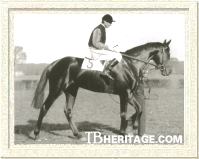
Magnat
| |
Astérus's success was not restricted to France, siring top class runners in Germany and Italy. Gestut Schlenderhan bred MAGNAT (br.c. 1938 out of Mafalda by Wallenstein), the champion of his crop in Germany, winning the Deutches Derby, Henckel Rennen (German 2,000 Guineas), Grosser Preis von Baden Baden, Union Rennen and Ratibor Rennen. At stud at Schlenderhan, Magnat became a leading sire in Germany, getting classic winners Allasch, Armgard, Adios, Aubergne, Jonkheer; as well as important sire Nebelwerfer (sire of Kaiseradler, Kaiserkrone), and broodmare Schwarzblarot (ancestress of Sagace, Slip Anchor, and Steinlen).
|
In Italy, Astérus got the high class runners Chilone and Ostia. CHILONE (b.c. 1933 out of Kilted Kitty by Swynford) won 10 races in Italy including the prestigious Gran Premio del Jockey Club, Premio d'Autumno, Premio Natale di Roma and second in the St. Leger Italiano. He also won the Grosser Preis von Baden-Baden in Germany. OSTIA (b.f. 1931 out of Olba by Kibwesi) was produced from a half-sister to the great Ortello, probably the best racing son of Asterus's sire Teddy. At 2, Ostia won the Criterium Nazionale and was second in the Grand Criterium; at 3 she won the Premio del Jockey Club, Premio Campione d'Italia and third in the Oaks d'Italia.
|
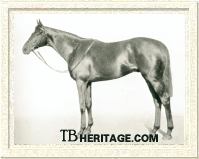
Abjer
| |
Most of the best of the rest by Astérus were bred and raced by Marcel Boussac. His ABJER (b.f. 1933 out of Zariba by Sardanapale) was sent to race in England, and there proved one of the best of his age, winning 2 of 5 starts at 2. His first win was in the Wilton Maiden Plate, then he ran second in the Champagne Stakes, won by future Derby winner Mahmoud, with Wyndham third (although Abjer had compromised that colt's race through interference early in the running). In the prestigious Middle Park Stakes, Abjer won by 2 lengths, defeating both Wyndham and Mahmoud. That season, Abjer was also second in the Imperial Produce Stakes and third in the Chesham Stakes. At season's end, Abjer was co-second highweight with Mahmoud behind Bala Hissar. At 3, Abjer was not the same horse, and was out of the money in the 2,000 Guineas and Derby before he was retired.
|
Boussac brought Abjer home to stand at stud at Haras Fresnay-le-Buffard alongside his sire Astérus, and he proved successful, although not a perfect replacement for his sire, who died shortly thereafter. Abjer sired Nosca, Hierocles, Tifinar, and Caravelle in his first 2 crops, but nothing of note afterwards and died young, in 1945, his career perhaps affected adversely by the conditions of war. Abjer was the second leading sire in France in 1943, when his daughter Caravelle won the Poule d'Essai des Pouliches (French 1,000 Guineas) and Prix de Diane (French Oaks). Caravelle produced the champion filly Cordova, Newmarket St. Leger winner Charleval and Prix Vermeille/Newmarket Oaks winner Janiari. Abjer also sired Prix Royal Oak winner Tifinar, who became the Leading Sire in France in 1957 (when his son Oroso won the Prix de l'Arc de Triomphe).
Abjer's other good colts included Nosca and Hierocles. Nosca, winner of the Grand Critérium and Critérium de Maisons-Laffitte, raced for Boussac and became a good sire for Francois Dupre. Hierocles, winner of the Prix la Rochette at 2, and 2-time winner of the Prix d'Ispahan, was briefly used as a replacement for Abjer, but was sold to America in late 1947. Hierocles wasn't a booming success in either France or America, but left 2 daughters in the U.S., one of which became the ancestress of Kentucky Derby winner Gato Del Sol and champion Tersa; and the other the ancestress of the great racemare Dahlia.
From the same crop as Abjer came DADJI (br. c. 1933 out of Perle d'Orient by Buchan), who awon the Grosser Preis von Baden, as well as the Prix du Cadran (French Gold Cup) and Grand Prix de Ville de Vichy. ASTROLOGER (b.c. 1935 out of Roseola by Swynford) also won the Prix du Cadran.
|
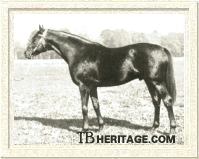
Jock
| |
Boussac also bred JOCK (b.c. 1936 out of Naic by Gainsborough), who won 7 of 12 starts including the Grand Prix de Deauville, Prix Henry Greffulhe and Prix des Marechaux. At stud, he sired Sunny Boy (Leading Sire in France in 1954, when Sun Cap, Sica Boy, and Soleil Levant were all top class; he later sired Midnight Sun and Tamanar as well). Jock also left a lot of good fillies, including the dams of Tale of Two Cities (sire of Cougar II), Talgo and Fidalgo (half brothers who won the Irish Derby), Datour, and Djenne (dam of Olden Times)
|
Comte de Rivaud's Astérus colt, ASSUERUS (br.c. 1930 out of Slip Along by Hurry Along), won 7 races incluidng several of the highest class: the Prix de la Foret, Prix d'Harcourt, Prix du President de la Republique, Prix du Conseil Municipal; as well as second in the Prix de l'Arc de Triomphe and third in the Grand Prix de Paris. Unfortunately, he did nothing at stud.
There were several lesser sons of Astérus who became important sires, however. ASTROPHEL (ch.c. 1931 out of Dorina by La Farina) was out of the champion racemare Dorina, making him a brother to the good filly Dulce and half-brother to Fox Cub (a leading sire in Argentina). Durable Astrophel won 20 races from 43 starts including several international Grand Prix, and at stud in France, numbered among the leading sires on several occasions, including second in 1949. His best offspring included Grand Prix de Paris winner Bagheera and Prix Vermeille winner Folle Nuit.
ATYS (b.c. 1934 out of Esclarmonde by Sunstar) was a Boussac-bred and won the minor Prix Melbourne and at stud, his primary donation was the good stayer Pan, winner of the Prix Royal Oak, Ascot Gold Cup, and Goodwood Cup.
|
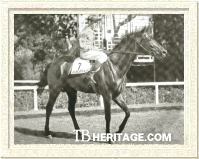
Asbestos
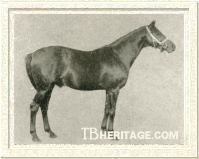
Kipling
| |
ASBESTOS (b.c. 1932 out of Cnidos by Orpheus). Bred and raced by Lord Derby, Asbestos won the Prix Thormanby and a few other stakes in France, and continued his racing career after being sold and shipped to South Africa in 1938. There he became revitalized, winning 5 races in 15 starts including the Cape Metropolitan Handicap and Western Province Merchants Handicap. Retired to the Vogelvlie Stud, he was the Leading Sire in South Africa 5 times in succession posthumously as he died in 1946, and his first sire championship was in the 1945-1946 season.
KIPLING (b.c. 1936 out of Kandy by Alcantara II). His dam won the English 1,000 Guineas, but Kipling did little in his home country of France. Sent to South Africa, he won the Durban July Handicap and Suburban Handicap. Furthermore, he went on to become the Leading Sire there in 1951-1952.
Astérus's son FORMASTERUS (ch.c. 1931 out of Formose by Clarissimus) was bred in France by Andre Schwob and had a good half-brother named Formor (in the pedigree of Lyphard). Like Kipling, he did nothing in his homeland but when shipped overseas, found a new sense of self. In Formasterus's case, home became Brazil, where he was sent as a 4-year-old, and later won the Gran Premio Sao Paulo in 1936 and several other top events. At stud in Brazil, he became the dominant sire of his time, Leading Sire 5 times.
|
Astérus Daughters
Now we turn to Asterus's daughters. We've already discussed the classy race fillies ADARGATIS (dam of Ardan, Pardal, Gabador, Adaris, and Pharatis) and SANAA (dam of Esmeralda, Abis, Nyangal and Narses).
|
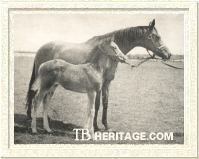
Astronomie with filly Arbele
| |
Marcel Boussac also bred the useful stakes winner ASTRONOMIE (b.f. 1932 out of Likka by Sardanapale), whose influence as a broodmare proved remarkable, with 8 stakes winners, led by the great stayers Marsyas (Prix du Cadran twice, Doncaster Cup, Goodwood Cup), Caracalla (Grand Prix de Paris, Prix Royal Oak, Ascot Gold Cup, Prix de l'Arc de Triomphe), and Arbar (Ascot Gold Cup, Prix du Cadran); plus the fillies Asmena (Epsom Oaks), White Rose (Newmarket Oaks), Arbele, Floriados, and Pharas.
|
THAOUKA (ch.f. 1929 out of Sweet Picture by Gainsborough) was one of Astérus's first stakes winners but made an even bigger impressionby producing no less than 7 stakes winners for Boussac including English St. Leger winner Talma, plus Astyanax, Caramida, Micipsa, Canzoni, Karali, and Timur.
ORLAMONDE (b.f. 1937 out of Naic by Gainsborough) was bred on the same cross as Thaouka, although was useless on the track, being unplaced. As a broodmare she made up for it, producing 4 stakes winners including Prix du Jockey Club (French Derby) and English St. Leger winner Scratch, also Janitor and Damnos.
DJEZIMA (ch.f. 1933 out of Heldifann by Durbar II) was a stakes winner at 2. As a broodmare, she produced 7 stakes winners, led by French champion 2-year-old Priam, plus the classy Djeddah (a sire of influence in the U.S.), Tourzima (dam of Corejada), and the lesser stakes winners Atal, Flamboyant de Fresnay, Pharima and Ismene. Both Djeddah and Tourzima were remarkably inbred individuals.
Those were the best, but there were many other top runners produced by Astérus's daughters. As a stallion, he was the Leading Sire in France in 1934, the year Adargatis and Sanaa were at their best. He was also the Leading Broodmare Sire 6 times in succession from 1943 through 1948. His forte was stamina even beyond the classics, as evidence by his many offspring and descendants with wins in the great distance events like the Prix Royal Oak, Prix du Cadran, St. Leger, and Ascot Gold Cup.
As an individual, Astérus was a solid bay, and an extremely beautiful horse, oozing class and quality. In that, he is possibly the source of what became the classic "Boussac look" which made them a sub-strain of modern Thoroughbred. The "look" was typified by horses of exquisite beauty, with small, ultra refined heads, often compared to Arabians. They usually had beautiful balance, high energy although possibly a little light of bone, a stamp that remains a stamp on his descendants into modern times.
Astérus died following a heart attack at Haras de Fresnay-le-Buffard in February 1938 at the age of 15. He was succeeded at his home stud by sons Abjer and Jock, but several of his better stallion sons were shipped out of France and became Leading Sires around the world, spreading his influence globally, like many of the best sons of his sire, the great dynasty-maker Teddy.
-- Anne Peters |
|
|
|

